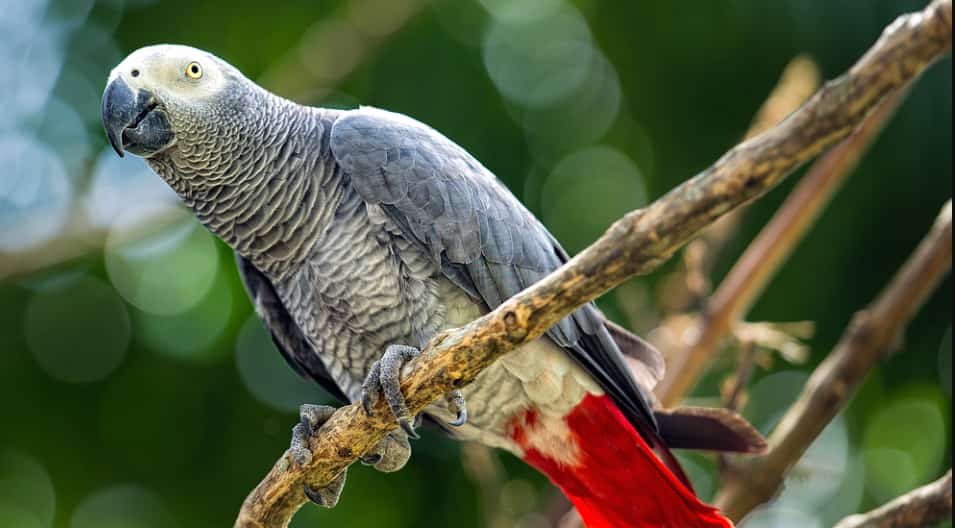African Grey Parrots
African Grey parrots are celebrated for their intelligence and striking looks, making them a favorite among bird lovers worldwide.
Originating from the lush rainforests of West and Central Africa, these birds are renowned not only for their beauty but also for their remarkable ability to mimic human speech and grasp complex ideas, reflecting their high cognitive abilities.
This article provides a comprehensive look at African Grey parrots, covering their habitat, physical traits, behavior, dietary needs, and care requirements. Understanding these elements will help enthusiasts not only to foster these parrots in homes but also to respect them as a sophisticated and fascinating species.
Natural Habitats of African Grey Parrots
African Grey parrots are divided into two main types: the Congo African Grey (CAG) and the Timneh African Grey (TAG).
The Congo variety, which is larger, sports light grey feathers and a bright red tail, inhabits areas stretching from northeastern Ivory Coast to parts of Kenya, Tanzania, and southern Democratic Republic of Congo. The smaller Timneh type, with its darker grey and maroon tail, is found mainly in the western regions of the Ivory Coast and up to Guinea.
These parrots reside in diverse forested regions ranging from dense primary rainforests to more accessible secondary forests, and even in landscaped regions close to human populations. These environments provide them with necessary resources like fruits, nuts, and seeds, and places to nest in the high trees.

Characteristics and Care of African Grey Parrots
Physical Features
African Grey parrots are distinguished by their grey plumage—the Congo variety has a striking red tail while the Timneh sports a maroon tail. These features help in identifying the species and understanding their breeding patterns.
Behavior and Interaction
Known for their social intelligence, these parrots exhibit a range of behaviors from mimicking speech to showing affection. Their ability to interact and communicate effectively makes them highly engaging pets.
Diet and Nutrition
Their diet mainly consists of fruits, nuts, and seeds. In captivity, it is crucial to provide a balanced diet that replicates what they would find in the wild to prevent nutritional deficiencies.
Environmental and Housing Needs
Adequate cage size, stimulating toys, and proper lighting and temperature control are essential to mimic their natural habitat and keep them healthy and active. Environmental safety and regular social interaction are also crucial for their well-being.
Health and Lifespan
With proper care, African Grey parrots can live for many decades, making them a long-term commitment. They require regular veterinary check-ups to maintain their health.
Challenges and Conservation
Despite their adaptability, these parrots face challenges like habitat destruction and the illegal pet trade. Conservation efforts are vital to ensure their survival and the preservation of their natural habitats.
Also read: Ultimate Guide to Parrot Weight: Explore Sizes of 90+ SpeciesBy delving into these aspects, bird enthusiasts can appreciate and better care for African Grey parrots, recognizing them as an intricate part of our natural world and as cherished companions.
African Grey Parrots: Essential Characteristics and Care
Physical Attributes of African Grey Parrots
African Grey parrots, celebrated for their cognitive abilities, boast distinct physical traits that differentiate the Congo African Grey and Timneh African Grey species.
The larger Congo variant, approximately 12 to 14 inches in length, displays light grey feathers and a vivid red tail, complemented by a featherless, pale-skinned eye area and a robust black beak suitable for cracking nuts.
The smaller Timneh parrot, measuring about 9 to 11 inches, features darker grey plumage, a maroon tail, and a horn-colored beak, setting it apart from its Congo counterpart. Both species exhibit zygodactyl feet, ideal for handling objects, which underscores their reputation as proficient manipulators.
Read more: Distinguishing Male from Female Parrots Distinguishing Male from Female Parrots
African Greys show signs of sexual dimorphism, particularly observable in the Congo African Grey after their first molt. Males typically have a solid red under-tail, while females might have silver-tipped tails, although variations exist.
Under-wing coloration also varies; males display a darker hue compared to the lighter grey found in females. These characteristics, however, are more pronounced in Congo parrots than in Timnehs, making the latter harder to differentiate by sex. For accurate determination, DNA testing is recommended.

Behavioral and Personality Traits
Renowned for their intelligence, African Grey parrots have a profound ability to mimic human speech and understand commands, reflecting advanced cognitive functions akin to young children.
They are emotionally sensitive, requiring significant interaction and mental stimulation to avoid distress. Their need for social engagement, inherent curiosity, and playful nature necessitates a variety of toys and activities to prevent boredom and promote mental health.
Dietary Needs
In the wild, African Greys’ diet includes fruits, nuts, seeds, and some insects. Captive parrots thrive on a similar varied diet, enriched with fresh produce and high-quality pellets, while seeds and nuts should be limited due to their high-fat content.
Given their susceptibility to calcium deficiency, a balanced intake of nutrients, possibly supplemented under veterinary guidance, is crucial.
Also read: +10 Nutritional Guide for Parrots: Best and Worst FoodsEnvironmental Requirements for Optimal Health
The living space for an African Grey should be spacious, with a minimum recommended cage size that allows them to move freely and stretch their wings. The cage should be placed in a socially interactive yet calm environment, safe from kitchen fumes and direct sunlight.
Regular changes to their setup, including varied perching options and safe toys, help keep these intelligent birds engaged and comfortable.
Ensuring Longevity and Well-being
With a lifespan that can extend up to 60 years, African Greys require committed caregiving that includes regular veterinary check-ups, a balanced diet, and adequate mental and physical exercise.
Awareness of environmental safety, such as avoiding toxic substances and ensuring secure living quarters, is vital to prevent accidents and health issues.
Breeding Insights
Breeding African Grey parrots calls for understanding their behaviors and environmental needs deeply. Successful breeding depends on providing a stress-free atmosphere, a compatible pair, and appropriate nesting conditions.
Attention to diet and health during the breeding period is critical for both the adult parrots and their chicks.
Conclusion:
caring for African Grey parrots demands a comprehensive understanding of their dietary, environmental, and social needs. These parrots are not just pets but intelligent and sensitive companions that enrich the lives of their caregivers with deep, rewarding relationships. Proper care ensures these charismatic birds thrive in captivity, offering a fulfilling experience for both the parrot and its owner.
FAQ’s:
What are the physical differences between Congo and Timneh African Grey parrots?
Congo African Greys are larger with light grey plumage and a red tail, while Timneh African Greys are smaller, darker, and have a maroon tail.
How can you tell the difference between male and female Congo African Grey parrots?
Male Congo African Greys usually have a solid red color under their tail feathers, while females may have silver-tipped tails.
What are some personality traits of African Grey parrots?
African Grey parrots are highly intelligent, capable of mimicking speech and sensitive to their emotional environment, requiring interaction and mental stimulation.
What dietary considerations are important for African Grey parrots?
Their diet should be varied, including fresh fruits, vegetables, high-quality pellets, and limited seeds and nuts due to their high-fat content.
What are the key environmental needs for African Grey parrots?
African Greys need a spacious cage placed in a socially interactive yet stable environment, safe from hazards and extreme temperatures.
